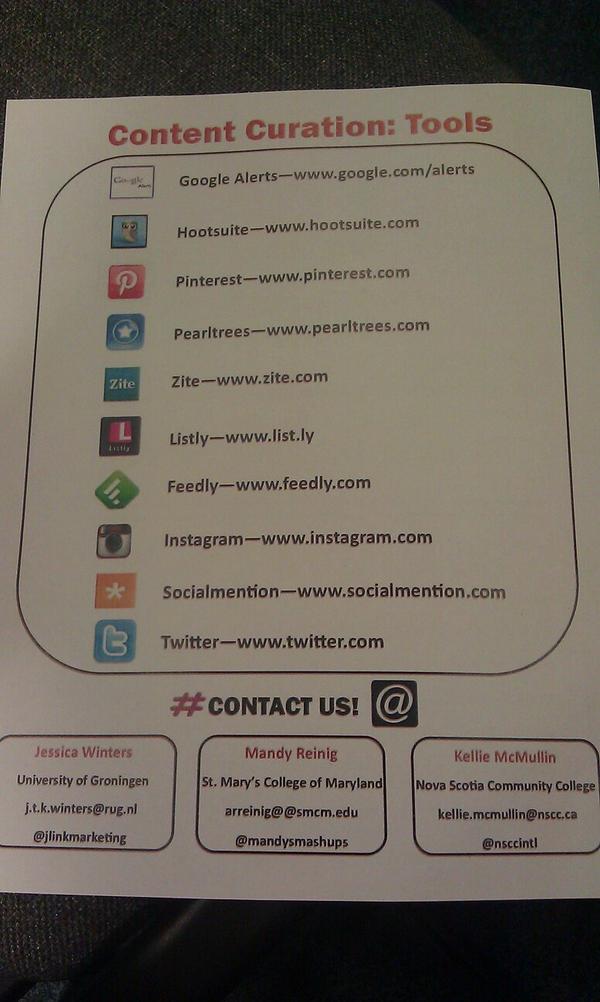Social media content curation: tips, tricks and winning strategies
Chair: Jessica Winters, University of Groningen, Netherlands
What is good content? How to find good content? What to post where?
Mandy Reinig, St. Mary’s College of Maryland, USA
What is content curation? search, filter, sort and present content.
- Spot it
- Stock it
- Share it
Curation is manually sourcing and posting content relevant to your niche and audience, while aggregation is automated feeds/content collected from using key words/phrases. Content curation takes more time.
Kellie McMullin, Nova Scotia Community College, Canada
Content curation strategy:
- Who is your target audience? Knowing your audience, their interests, is key.
- What are your goals? You have to have them, so that you can measure your performance and your impact: contact, inform, customer service, recruitment, branding, etc.
- What types of sources do you want to draw from?
- What content collection tools do you want to use?
- How often will you check for new content? It depends on the platform and, especially, on the goals. Consistency is key.
- Who will check for new content? It is not as important the who but consistency in who is in charge of it. Using students can be a good bet, as they often are the target audience themselves, are savvy on social media use.
- How often will you post the content?
Jessica Winters, University of Groningen, Netherlands
Posting on Facebook:
- Best length is 80 characters or less (80-130 characters). The goal is to tease the user to click on the link, not to make them read the whole stuff on Facebook.
- Visual: add a picture or a good video.
- As questions.
- Be authentic, be honest.
- Quality, not quantity. It is better to post once a day a good thing than posting noise several times a day.
- Content: pride (being a student at the uni, stuff about the university, local/regional news/information), current events (only the relevant ones), college-humor, student-related, famous people.
It is important to identify one’s social ambassadors.
Kellie McMullin, Nova Scotia Community College, Canada
Content curation tools: how to choose the right tool for you? It depends on your goals, your audience and the form of content (pictures, videos, articles) that you want.

- Keep content simple. Simple things is what people will read.
- Be real and relevant.
- Post your passion. Don’t post because something has to be posted.
- Student-produced material. And tag the students’ content!
- Contests.
Jessica Winters, University of Groningen, Netherlands
If you aim at recruiting international students, you have to be on the social media that they are using, the sites that are popular in their respective countries, with their cultural codes, in their language.
Using Hootsuite as a content curation tool, not only for social media, but also to follow/subscribe to RSS feeds.
Discussion
Q: What about sponsord posts on Facebook? Winters: they work a little bit better than regular posts, but not too much. You can do that every now and then, it is not very expensive, but it is not terrific.
Ismael Peña-López: what about content produced by faculty members? Winters: the problem with this content is not quality —which is good— but the focus, which is usually too narrow and addressed to a very specific/specialized audience.
Q: What about trolls? Winters: we usually ignore them and, in fact, students themselves will many times fight them back.
26th Annual EAIE Conference (2014)
If you need to cite this article in a formal way (i.e. for bibliographical purposes) I dare suggest:
Peña-López, I. (2014) “EAIE2014 (III). Social media content curation: tips, tricks and winning strategies” In ICTlogy,
#132, September 2014. Barcelona: ICTlogy.
Retrieved month dd, yyyy from
https://ictlogy.net/review/?p=4253
Previous post: EAIE2014 (II). Jan Muehlfeit: stepping into a new era
Next post: EAIE2014 (IV). E-supervision: a new tool for enhancing PhD education in Africa
 RSS feed for comments on this post.
TrackBack URI
RSS feed for comments on this post.
TrackBack URI

